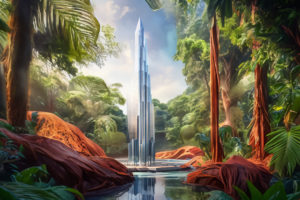 Obelisks and the Theory of Wireless Energy Reception (shared with Mu the Motherland)
Obelisks and the Theory of Wireless Energy Reception (shared with Mu the Motherland)
Who doesn’t love an obelisk? In the USA, the Washington Monument stands over 555 feet tall—a fusion of ancient inspiration and modern engineering. Similarly, the Luxor Hotel in Las Vegas, with its massive pyramid and accompanying obelisk, pays homage to ancient Egyptian architecture, albeit in a commercial and entertainment context. The word “obelisk” comes from the Greek “obeliskos,” which means “small spit” or “pointed pillar.” This is a testament to the Greeks’ fascination with these structures when they encountered them during their historical interactions with Egypt.
Beyond physical structures, the obelisk has found its way into modern culture as a symbol. In literature, film, and art, obelisks often represent power, endurance, and the mysteries of ancient civilizations. They serve as a bridge between the ancient and the modern, reminding us of the timeless nature of human achievement.
Obelisks were iconic symbols of the ancient Egyptians—primarily granite they were often inscribed with hieroglyphics that celebrated the reigns of the pharaohs or paid homage to the gods. The top of the obelisk was commonly covered in electrum (a mix of gold and silver) which would shine brilliantly under the sun. There’s a broader theory that prehistorical civilizations, particularly the Atlanteans, had access to advanced technology that has since been lost to time. The construction of the pyramids, the precision of their astronomical observations, and the building of massive structures like obelisks, all fuel this speculation.
One theory is that obelisks were used as receivers for wireless energy in ways that were lost with the Atlanteans. The Edgar Cayce readings say that the renowned inventor, Nikola Tesla, was the reincarnation of an Atlantean engineer who was in charge of the ancient energy grid. Nikola Tesla had a vision of providing the world with wireless energy. He believed that energy could be transmitted through the air, without the need for wires. Tesla’s experiments, particularly those at his Wardenclyffe Tower, aimed to demonstrate this possibility. Some proponents draw parallels between Tesla’s towers and ancient obelisks, suggesting that ancient civilizations might have had knowledge of wireless energy transmission.
In 1900 Tesla obtained two patents pertaining to wireless energy. In 1943 the U.S. Supreme Court acknowledged Tesla’s full patent rights for the invention of the radio denying Marconi’s claim to fame. Tesla further demonstrated that by the use of alternating current (AC) electricity could be sent long distances. For better or for worse, he got involved with the major industrialists of the time including George Westinghouse and Thomas Edison. Corporate profits were dependent on owning a wired power grid and charging customers for electricity. Tesla felt that stringing wires over the planet had many limitations and he continued to insist that wireless transmission was better.
The Wardenclyffe Tower was an experimental wireless transmission station, built on Long Island in 1902 that could transmit voice, written, and even facsimile images across the Atlantic to England. His idea, however, to compete with Marconi’s telegraph system met with disapproval of funds from business magnates such as J.P. Morgan, who couldn’t see how to earn high profits from the endeavor. Tesla never could find new funds and the tower was sold for scrap and the property foreclosed upon.
The physical structure of the Wardenclyffe Tower was an obelisk with a copper based hemispherical structure on the top. Inside the supporting building were various electromechanical devices, electrical generators, electrical transformers, glass blowing equipment, X-ray devices, Tesla Coils, a remote-controlled boat, cases with bulbs and tubes, wires, cables, a library, and an office. Underground tunnels housed many experiments that added to the mystery of the man and place. Tesla continued to pursue financing from many of the mega-wealthy of the time to no avail. Tesla continued to argue (until his death and the confiscation of his research by the FBI in 1943) that clean, cheap, limitless electrical energy could be transmitted without the wires, we are so used to seeing, strung across almost every section of the planet. Today, we take similar technology and the Wi-Fi tower systems for granted. However, these satellite systems do not use the beautiful and mystical obelisks as transmitters; leaving us to wonder if our attraction to them is simply that they make us feel peaceful, powerful, and enlightened.
ShareSEP
2023


About the Author:
Elaine Webster writes fiction, creative non-fiction, essays and poetry from her studio in Las Cruces, New Mexico—in the heart of the Land of Enchantment. “It’s easy to be creative surrounded by the beauty of Southern New Mexico. We have the best of everything—food, art, culture, music and sense of community.”